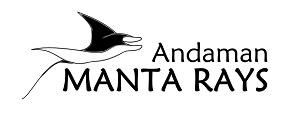Hilde van de Sande
The Andaman Manta Ray project is the first to study the Manta Ray population of the Andaman Islands, located in the Bay of Bengal. Although manta rays have been observed in this region, no research has been conducted on this population, and this project aims to raise awareness about these manta rays and their conservation through research and education.

Manta ray diagram.
Manta Rays are listed as Vulnerable on the IUNC Red List, and increasingly threatened around the world mainly by fisheries, pollution, habitat destruction, climate change and unregulated tourism. The need for their conservation is recognized in certain countries, however little is known about their biology and ecology. In the Andaman Islands (India) located in the Bay of Bengal, manta rays have been observed but not yet researched - and receive no local or national protection.

Andaman Manta Rays logo.
We therefore decided to conduct this study, to collect valuable information about this population, and use it to further their protection. The study will use photo-identification, a non-invasive technique used globally to study manta populations, the records of which will be added to a global database, allowing scientists to monitor the movements and migration patterns of manta populations over time, estimate the population size, and learn about their social structure.
Project Goals:
- Investigate the manta and mobula ray population in the Andaman Islands.
- Develop a database for mantas and mobula rays in this region through photo-identification, and add the data to the global manta ray database, where it can be used to further research manta migration patterns, and help determine the health of the manta population.
- Train local interested parties or individuals in conducting this research so that the database can be regularly updated and developed.
- Conduct a preliminary investigation of the Andaman fisheries in order to estimate human threats to the local manta population.
- Raise awareness and about these species and their conservation.
Why this is important:
Identification of manta and mobula ray aggregation sites is key to their conservation. Assessing the populations by photo-identification and adding the data to the global manta database allows for further conservation measures to be taken. Raising awareness about these species can potentially reduce careless by-catch fishing, increase responsible tourism, support habitat conservation, and help regulate the manta/mobula fishing and export industry. India, Indonesia and Sri Lanka are among the world’s greatest exporters of dried manta/mobula gills, which are used in the Chinese medicinal trade - their fisheries are responsible for ~90% of recorded manta ray mortality (Manta Trust 2013). The low fecundity as well as slow growth and maturation rates of manta and mobula rays increase their vulnerability to fishing. No study has thus far been conducted in the Andaman Islands to determine the fishing pressure and the need for their protection (Manta Trust 2013).